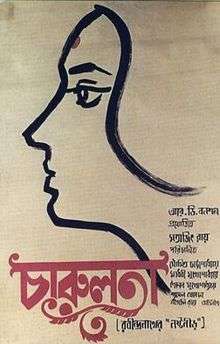Charulata
| Charulata | |
|---|---|
 A poster for Charulata. | |
| Directed by | Satyajit Ray |
| Produced by | R.D.Bansal |
| Screenplay by | Satyajit Ray |
| Based on |
Nastanirh by Rabindranath Tagore |
| Starring |
Soumitra Chatterjee, Madhabi Mukherjee, Sailen Mukherjee, Syamal Ghosal |
| Music by | Satyajit Ray |
| Cinematography | Subrata Mitra |
Production company |
R.D.Bansal & Co. |
| Distributed by | Edward Harrison (US) |
Release dates |
|
Running time | 117 minutes |
| Country | India |
| Language | Bengali with some English |
Charulata (Bengali: চারুলতা Cārulatā; in English also known as The Lonely Wife) is a 1964 Indian Bengali drama film by director Satyajit Ray, based upon the novella Nastanirh ("The Broken Nest") by Rabindranath Tagore. It features Soumitra Chatterjee, Madhabi Mukherjee and Sailen Mukherjee.
Plot
The film tells the story of a lonely housewife, known as Charu (Madhabi Mukherjee), who lives a wealthy, secluded and idle life in 1870's Calcutta. Her husband, Bhupati (Sailen Mukherjee), runs a newspaper, The Sentinel, and spends a lot more time at work than with his wife. However, he notices that Charu is lonely, and asks his cousin, Amal (Soumitra Chatterjee), to keep her company. Amal is a writer and is asked to help Charu with her own writing. However, after some time, Charu and Amal's feelings for each other move beyond those of a mentoring relationship.
Cast
- Soumitra Chatterjee - Amal
- Madhabi Mukherjee - Charulata
- Shailen Mukherjee - Bhupati Dutta
- Shyamal Ghoshal - Umapada
- Gitali Roy - Manda
- Bholanath Koyal - Braja
- Suku Mukherjee - Nishikanta
- Dilip Bose - Shashanka
- Joydeb - Nilotpal Dey
- Bankim Ghosh - Jagannath
Production
Charulata is based on the 1901 novella Nastanirh (The Broken Nest) by Bengali author Rabindranath Tagore.[1] Ray later said that he liked the novella because "it has a western quality to it and the film obviously shares that quality. That's why I can speak of Mozart in connection with Charulata quite validly."[2] Ray decided to set the film in the 1880s instead of in 1901 and spent many months researching the historical background. For the first time in his career he worked without a deadline both during pre-production and during the shooting.[3] Ray worked closely with art director Bansi Chandragupta and no interior scene was shot on location. All sets were either built or remodeled to accurately portray India in the 1880s. Ray cast Indian actress Madhabi Mukherjee in the role of Charulata, but had difficulty with her owing to her addiction to chewing paan, which stained her teeth black. Because of this Ray had to be careful about what camera angles he used to film her.[4] Ray once called Charulata his favourite of his own films.[5]
Reception
Charulata holds one of the highest ratings for an Indian film in Rotten Tomatoes, a 96% 'fresh' rating. It also holds an 8.4/10 rating on imdb. It has been widely regarded as one of the finest films made in Indian cinema history, and has won wide critical acclaim overseas as well.
In Sight and Sound, Penelope Houston praised the film, stating that "the interplay of sophistication and simplicity is extraordinary".[6] A New York Times review said that the film "moved like a majestic snail, as do all Ray films".[5] In 1965, The Times of London remarked upon the film's depiction of values that seemed influenced by the English, stating that "this stratum of Indian life was more English than England".[5]
It was shown as part of the Cannes Classics section of the 2013 Cannes Film Festival.[7]
Preservation
The Academy Film Archive preserved Charulata in 1996.[8]
Awards
- Silver Bear for Best Director at the 15th Berlin International Film Festival in 1965.[9]
- Golden Lotus Award for Best Film at the National Film Awards (India) in 1965.
Tribute

The film contains a famous scene in which Charu (Madhabi Mukherjee) sings Rabindranath Tagore's song "Fule Fule Dhole Dhole" on a swing, while looking at Amal (Soumitra Chatterjee). The scene is referenced in the Bollywood film Parineeta during the song sequence, Soona Man Ka Aangan. Indeed, Parineeta 's Lalita (Vidya Balan) is dressed to resemble Nastanirh/Charulata 's Charu. Furthermore, Parineeta is based upon the novel Parineeta by Sarat Chandra Chattopadhyay who was a noted contemporary of Tagore (and who also wrote novels concerned with social reform).[10][11]
Home media
In 2013, The Criterion Collection released a restored high-definition digital transfer and new subtitle translations.[12]
References
- ↑ Robinson, Arthur. Satyajit Ray: The Inner Eye. Los Angeles: University of California Press. 1989. ISBN 0-520-06905-6. pp. 159.
- ↑ Robinson. pp. 160.
- ↑ Robinson. pp. 161.
- ↑ Robinson. pp. 162.
- 1 2 3 Robinson. pp. 157.
- ↑ Robinson. pp. 156.
- ↑ "Cannes Classics 2013 line-up unveiled". Screen Daily. Retrieved 2013-04-30.
- ↑ "Preserved Projects". Academy Film Archive.
- ↑ "Berlinale 1965: Prize Winners". berlinale.de. Retrieved 2010-02-20.
- ↑ Gupta, Pratim D. (2005-06-11). "The Telegraph - Calcutta : Nation". Calcutta, India: Telegraphindia.com. Retrieved 2011-05-31.
- ↑ "Magazine / Lifestyle : Something new, something old". Chennai, India: The Hindu. 2005-08-07. Retrieved 2011-05-31.
- ↑ "Charulata: "Calm Without, Fire Within" – From the Current – The Criterion Collection". Retrieved 2015-03-19.
Further reading
- Antani, Jay. "Charulata review." Slant Magazine, April 2004.
- Biswas, Moinak. "Writing on the Screen: Satyajit Ray’s Adaptation of Tagore"
- Chaudhuri, Neel. "Charulata: The Intimacies of a Broken Nest"
- Cooper, Darius.The Cinema of Satyajit Ray:Between Tradition and Modernity Cambridge University Press, 2000.
- Nyce, Ben. Satyajit Ray : A Study of His Films. New York: Praeger, 1988
- Seely, Clinton B. "Translating Between Media: Rabindranath Tagore and Satyajit Ray"
- Sen, Kaustav "Our Culture, Their Culture:Indian-ness in Satyajit Ray and Rabindranath Tagore explored through their works Charulata and Nashtanir"